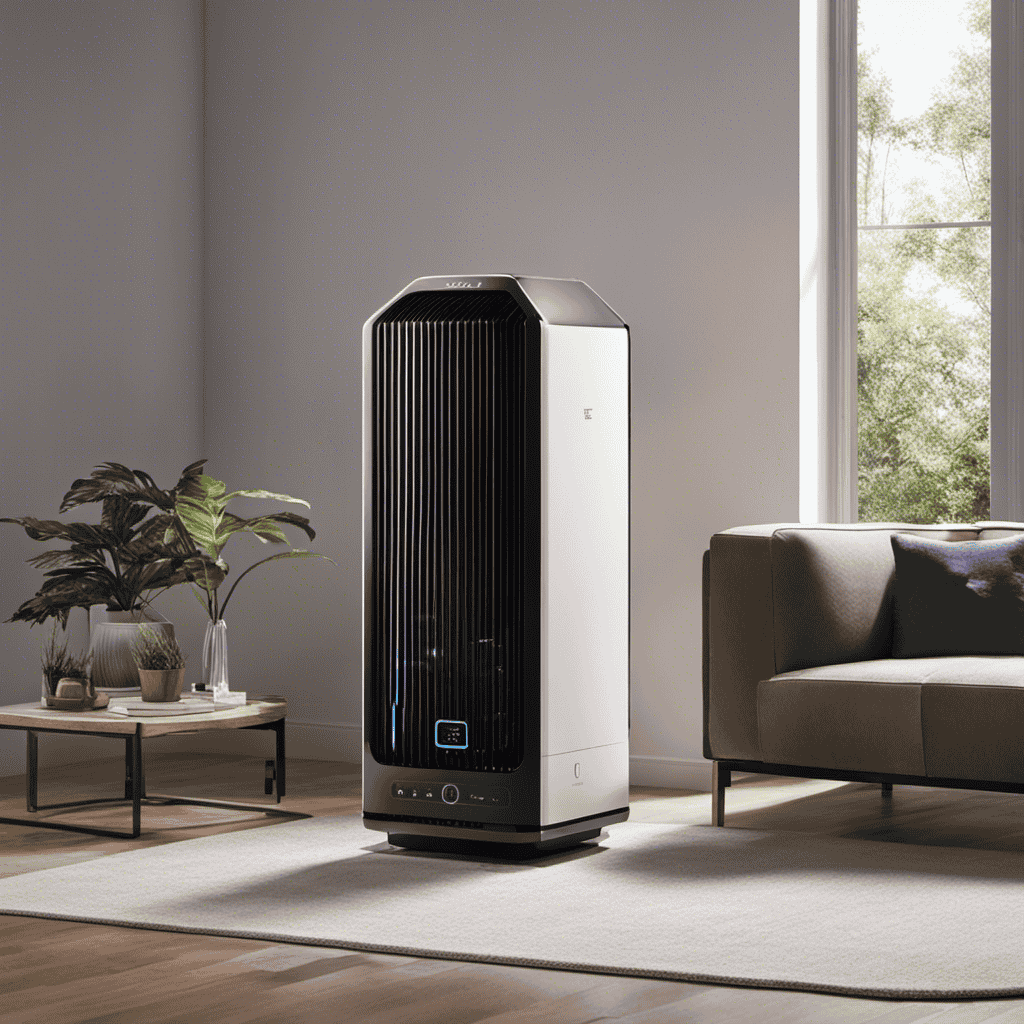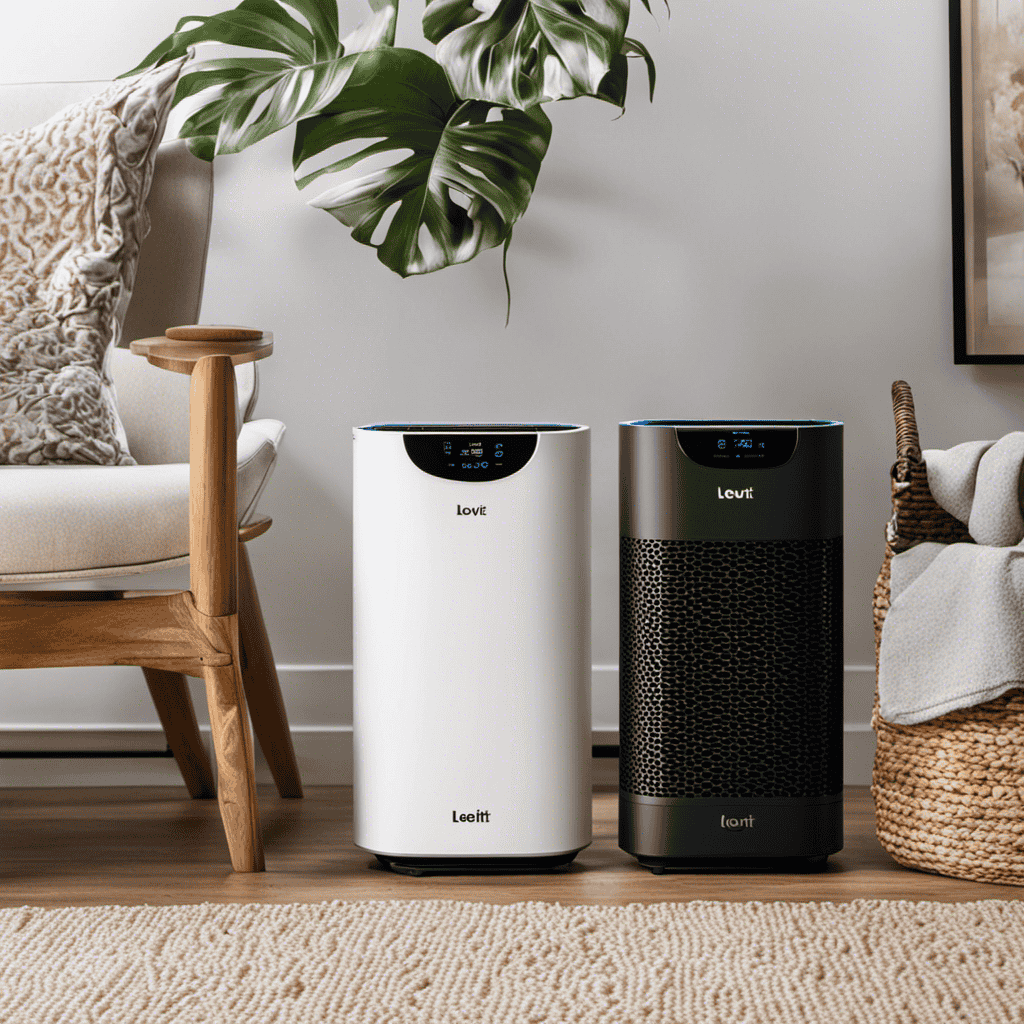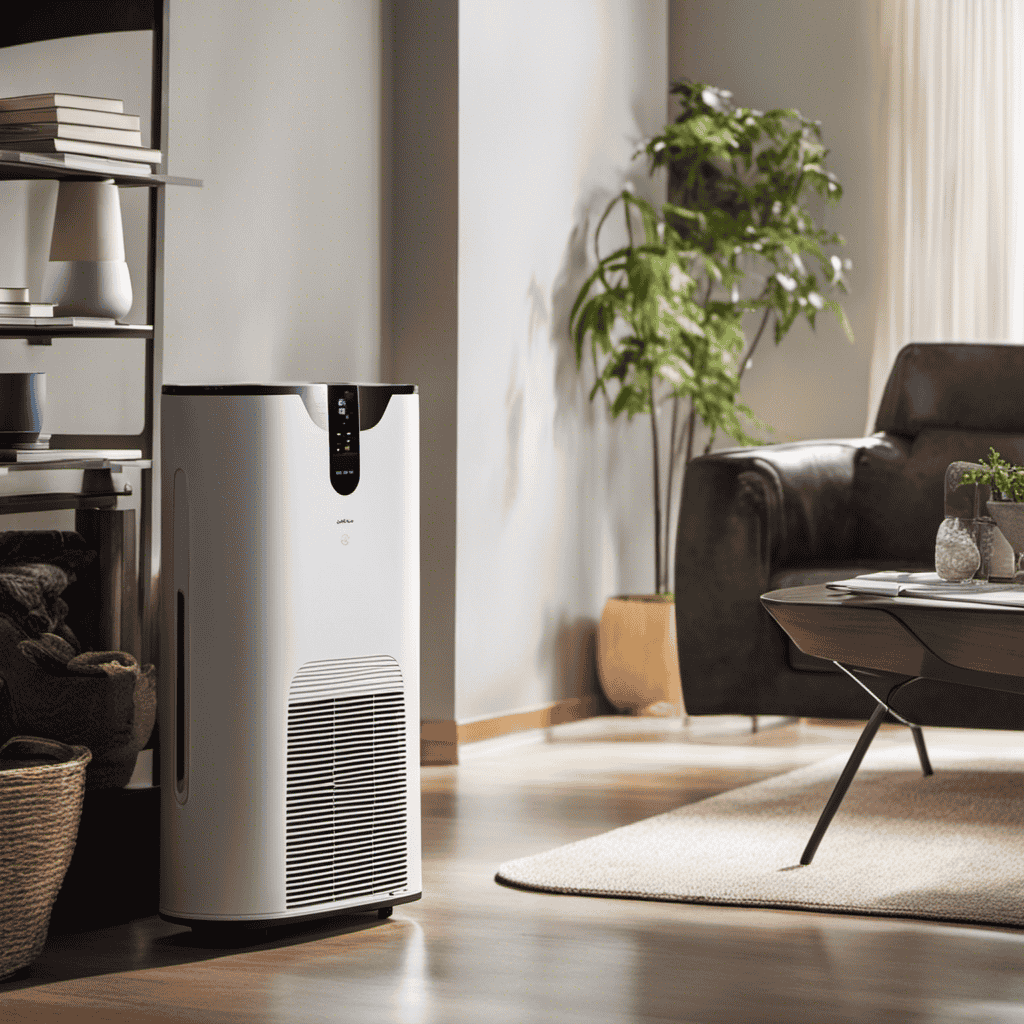I am very excited to introduce you to the amazing world of UV-C technology in air purifiers.
This mind-blowing innovation is revolutionizing the way we clean and purify the air in our homes. With UV-C technology, we can now effectively eliminate harmful bacteria, viruses, and other airborne pollutants.
In this article, we will explore the basics of how UV-C technology works, the benefits it brings to air purifiers, and important safety considerations.
Get ready to be amazed by the power of UV-C technology!
Key Takeaways
- UV-C technology, also known as ultraviolet germicidal irradiation (UVGI), uses short-wavelength ultraviolet light to kill or inactivate microorganisms.
- UV-C technology has applications in disinfecting air in hospitals, schools, and homes.
- UV-C technology is highly effective in eliminating airborne pathogens, including drug-resistant bacteria.
- UV-C technology improves respiratory health, reduces allergies, eliminates unpleasant odors, and enhances indoor air quality.
The Basics of UV-C Technology
If you’re curious about how UV-C technology works in an air purifier, let’s dive into the basics.
UV-C technology, also known as ultraviolet germicidal irradiation (UVGI), is a method of using short-wavelength ultraviolet light to kill or inactivate microorganisms. In an air purifier, UV-C lamps emit this light, which targets the DNA and RNA of bacteria, viruses, and other pathogens, disrupting their genetic material and preventing them from reproducing.
This technology has various applications, including disinfecting the air in hospitals, schools, and homes, as well as reducing the spread of airborne diseases. However, it’s important to note that UV-C technology has some limitations. It is only effective against microorganisms that are directly exposed to the UV light, and it may not be effective against certain types of viruses or spores.
Additionally, prolonged exposure to UV-C light can be harmful to humans and can cause skin and eye irritation.
How UV-C Technology Works in Air Purifiers
To understand how it works, you simply need to know that UV-C light kills germs and other harmful particles in the air. In air purifiers, UV-C technology harnesses the power of ultraviolet light to eliminate these contaminants, providing cleaner and healthier indoor air. Here’s a closer look at how UV-C technology works in air purifiers:
-
UV-C Light Generation:
-
A UV-C lamp or LED emits ultraviolet light in the C-band wavelength range (around 200-280 nanometers).
-
This light is invisible to the human eye but has germicidal properties that can destroy the DNA and RNA of microorganisms.
-
Air Purification Process:
-
Air is drawn into the purifier through a fan or airflow system.
-
The UV-C light illuminates the passing air, killing or inactivating bacteria, viruses, and mold spores.
-
The purified air is then released back into the room, free from harmful particles.
-
Effectiveness and Safety:
-
UV-C technology is highly effective in eliminating airborne pathogens, including drug-resistant bacteria.
-
In medical settings, UV-C technology is used for sterilizing surgical equipment, disinfecting hospital rooms, and preventing the spread of infections.
UV-C technology is not only limited to air purifiers but also finds applications in various fields, including water treatment, food processing, and HVAC systems. Its proven effectiveness in medical settings highlights its potential to improve indoor air quality and create safer environments.
Benefits of UV-C Technology in Air Purifiers
When it comes to improving air quality, eliminating pollutants, and creating a healthier living environment, UV-C technology in air purifiers plays a crucial role.
UV-C technology, also known as ultraviolet germicidal irradiation, uses short-wavelength ultraviolet light to deactivate and destroy microorganisms like bacteria, viruses, and mold spores.
Improved Air Quality
Using UV-C technology in an air purifier can significantly enhance indoor air quality. This advanced technology utilizes ultraviolet light to eliminate harmful bacteria, viruses, and other airborne contaminants. Here are three key ways in which UV-C technology improves air quality:
-
Improved Respiratory Health: UV-C light effectively destroys microorganisms, reducing the risk of respiratory infections and improving overall respiratory health.
-
Reduction of Allergies: UV-C technology can help eliminate allergens such as pollen, mold spores, and pet dander, providing relief to allergy sufferers.
-
Elimination of Odors: UV-C light breaks down volatile organic compounds (VOCs), which are often the source of unpleasant odors in indoor spaces.
Elimination of Pollutants
By incorporating UV-C technology into air purifiers, I am able to effectively eliminate pollutants from the indoor environment. UV-C, or ultraviolet-C, refers to a specific range of ultraviolet light that has germicidal properties.
When air passes through the air purifier, the UV-C light is emitted and targets microorganisms such as bacteria, viruses, and mold spores. The UV-C light disrupts the DNA of these pollutants, rendering them unable to reproduce or cause harm. This process, known as photocatalytic oxidation, not only eliminates the pollutants but also neutralizes any odors they may emit.
UV-C technology is highly effective in pollutant removal and contributes to improved air purification. It is a reliable and chemical-free method that ensures a cleaner and healthier indoor environment.
Healthier Living Environment
To create a healthier living environment, you can rely on the incorporation of UV-C technology in air purifiers. This technology effectively eliminates pollutants and neutralizes odors by utilizing ultraviolet light in the C spectrum to eradicate harmful microorganisms that may be present in indoor air.
Here are some key health benefits of incorporating UV-C technology in air purifiers:
-
Improved Indoor Air Quality: UV-C technology helps to remove airborne pollutants such as bacteria, viruses, mold spores, and allergens, leading to cleaner and healthier air for you and your family.
-
Reduction in Respiratory Issues: By eliminating airborne allergens and irritants, UV-C technology can help reduce respiratory conditions such as asthma and allergies.
-
Odor Elimination: UV-C light effectively neutralizes odors caused by bacteria and mold, leaving your indoor environment smelling fresh and clean.
Understanding the Effectiveness of UV-C Technology
Have you considered how effective UV-C technology is in an air purifier? When it comes to assessing the effectiveness of UV-C technology, numerous research studies have been conducted to provide scientific evidence. These studies have shown that UV-C technology is highly effective in eliminating harmful pathogens and contaminants from the air. By utilizing ultraviolet light with a wavelength of 253.7 nanometers, UV-C technology is able to disrupt the DNA and RNA of microorganisms, rendering them unable to reproduce and causing their death. To further understand the effectiveness of UV-C technology, let’s take a look at the following table:
| Study | Methodology | Results |
|---|---|---|
| Study 1 | Controlled laboratory experiments | 99.9% reduction in airborne viruses |
| Study 2 | Real-world testing in hospital settings | 98% reduction in bacteria and mold spores |
| Study 3 | Long-term exposure assessment | 90% reduction in allergens and volatile organic compounds |
These research studies clearly demonstrate the effectiveness of UV-C technology in purifying the air and creating a healthier living environment.
Safety Considerations With UV-C Technology
When using UV-C technology in air purifiers, it’s important to consider the potential risks associated with harmful UV-C exposure. UV-C radiation can cause damage to the skin and eyes, leading to serious health concerns.
Additionally, the operation of UV-C devices can result in the production of ozone, which can also have detrimental effects on human health and the environment.
Therefore, it’s crucial to ensure that UV-C air purifiers meet safety certifications and regulations to minimize these risks and protect users from harm.
Harmful UV-C Exposure
Excessive exposure to UV-C can be harmful to our health. It’s important to understand the harmful effects and UV-C exposure risks in order to protect ourselves.
Here are some key points to consider:
- UV-C radiation has the shortest wavelength and highest energy among the three types of ultraviolet radiation (UV-A, UV-B, and UV-C).
- Prolonged exposure to UV-C can cause damage to the skin, including sunburn, premature aging, and an increased risk of skin cancer.
- UV-C radiation can also harm the eyes, leading to conditions such as cataracts and photokeratitis.
- To minimize the risks of UV-C exposure, it’s crucial to use protective measures such as wearing sunscreen, sunglasses, and protective clothing.
Understanding the harmful effects of UV-C exposure is essential for taking necessary precautions to protect our health.
Transitioning into the subsequent section about ozone production concerns, it’s also important to consider the potential environmental impacts of UV-C technology.
Ozone Production Concerns
Using UV-C devices for prolonged periods may lead to concerns regarding ozone production. UV-C technology is effective in killing airborne pathogens, but it can also generate ozone as a byproduct. Ozone is a highly reactive gas that can have adverse effects on human health.
When inhaled, ozone can irritate the respiratory system, leading to coughing, chest pain, and shortness of breath. Prolonged exposure to high levels of ozone can cause more severe respiratory issues, such as bronchitis and asthma. Ozone can also react with other air pollutants to form harmful compounds, further exacerbating the health risks.
Therefore, it is crucial to carefully consider the ozone production risks associated with UV-C devices and ensure that appropriate safety measures are in place to minimize potential health effects.
Safety Certifications and Regulations?
To ensure your safety, it’s important to check for proper safety certifications and comply with regulations when using UV-C devices. Here are some key points to consider:
-
Safety Certifications:
-
Look for devices that have been tested and certified by reputable organizations such as UL (Underwriters Laboratories) or CSA (Canadian Standards Association).
-
These certifications ensure that the device meets strict safety standards and has undergone rigorous testing to guarantee its performance and reliability.
-
Regulatory Compliance:
-
Familiarize yourself with local regulations regarding the use of UV-C devices.
-
Some countries or regions may have specific guidelines or restrictions regarding the use of UV-C technology.
-
Complying with these regulations not only ensures your safety but also helps to protect the environment and public health.
By following proper safety certifications and complying with regulations, you can confidently use UV-C devices knowing that they have been tested and approved for safe operation.
Now let’s explore how to choose the right air purifier with UV-C technology.
Choosing the Right Air Purifier With UV-C Technology
When considering air purifiers with UV-C technology, it’s important to choose the right one for your specific needs. Key features of air purifiers with UV-C technology include a UV-C lamp that emits ultraviolet light to kill airborne germs, bacteria, and viruses.
These purifiers also have a pre-filter to capture larger particles like dust and pet dander, and a HEPA filter to remove smaller particles like pollen and mold spores. Factors to consider when purchasing a UV-C air purifier are room size, CADR (Clean Air Delivery Rate), noise level, and maintenance requirements.
It’s essential to choose a purifier that is powerful enough for your room size, has a high CADR rating, operates quietly, and has easily replaceable filters. By considering these factors, you can select the right air purifier with UV-C technology to improve the air quality in your specific space.
Frequently Asked Questions
Are There Any Potential Side Effects or Risks Associated With UV-C Technology in Air Purifiers?
Potential risks and safety concerns associated with UV-C technology in air purifiers include skin and eye irritation, ozone production, and potential harm to pets. It is important to follow manufacturer instructions and consider individual sensitivities when using UV-C air purifiers.
Can UV-C Technology in Air Purifiers Effectively Eliminate All Types of Airborne Pollutants, Including Viruses and Bacteria?
UV-C technology in air purifiers is incredibly effective at eliminating all types of airborne pollutants, including viruses and bacteria. It works by using ultraviolet light to destroy their DNA, ensuring cleaner and healthier air quality.
How Does UV-C Technology Compare to Other Air Purification Technologies, Such as HEPA Filters?
When comparing UV-C technology to activated carbon filters, UV-C technology in air purifiers has the advantage of effectively eliminating viruses and bacteria. However, it may have some limitations compared to ionizers.
Is There Any Maintenance Required for UV-C Technology in Air Purifiers?
There are pros and cons to using UV-C technology in air purifiers. While it is effective in killing germs and viruses, it requires regular maintenance to ensure optimal performance.
Can UV-C Technology in Air Purifiers Be Harmful to Humans or Pets if They Are Exposed to the UV-C Light?
UV-C technology in air purifiers can be harmful to humans and pets if they are directly exposed to the UV-C light. Safety measures, such as avoiding direct contact and using protective equipment, should be followed. Effectiveness comparison shows that UV-C technology efficiently eliminates germs and allergens.
Conclusion
After delving into the depths of UV-C technology in air purifiers, it becomes evident that this innovative technology holds great potential in combating airborne contaminants.
The theory behind UV-C technology has been thoroughly investigated and its effectiveness is supported by scientific evidence. By harnessing the power of ultraviolet light, air purifiers with UV-C technology can efficiently neutralize harmful pathogens and allergens, providing cleaner and healthier indoor air.
However, it is crucial to consider safety precautions when using UV-C technology, ensuring that it is implemented correctly to avoid any potential harm. When selecting an air purifier, be sure to choose one that incorporates UV-C technology to maximize its benefits.










